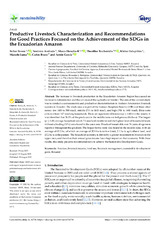Productive Livestock Characterization and Recommendations for Good Practices Focused on the Achievement of the SDGs in the Ecuadorian Amazon
Autor
Torres, Bolier
Andrade, Verónica
Heredia-R, Marco
Toulkeridis, Theofilos
Estupiñán, Kleber
Luna, Marcelo
Bravo, Carlos
García Martínez, Antón Rafael
Editor
MDPIFecha
2022Materia
AmazonLivestock income
Land use
Livestock management
Sustainable development goals
Ecuador
METS:
Mostrar el registro METSPREMIS:
Mostrar el registro PREMISMetadatos
Mostrar el registro completo del ítemResumen
The increase in livestock production in the Ecuadorian Amazon Region has caused an increase in deforestation and the advance of the agricultural frontier. The aim of the current study was to conduct a socioeconomic and productive characterization in Andean-Amazonian livestock systems in Ecuador. The study area was part of the Sumaco Biosphere Reserve (SBR) and three other zones: low (400 to 700 masl), middle (701 to 1600 masl), and high (701 to 1600 masl). Data were collected from 167 ranching households. There are significant differences (p ≤ 0.001) in the results. It was identified that 56.1% of the producers in the middle zone are indigenous (Kichwa). The largest (p ≤ 0.01) average household size (6.7 household members) and the highest level of household heads without schooling (16%) were found in the same area. Heads of households over 54 years of age were reported throughout the gradient. The largest farms were also found in the middle zone, with an average of 62.3 ha, of which an average of 32.9 ha is native forest, 2.1 ha is agricultural land, and 27.2 ha is cattle pasture. The household economy is driven by a greater investment in livestock in the upper area, and therefore their annual gross income has a high impact on their economy. With these results, this study presents recommendations to achieve the Sustainable Development Goals.

